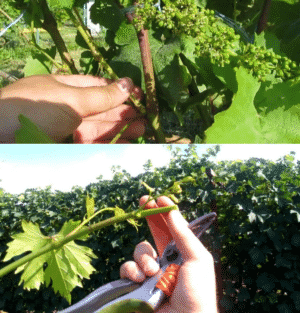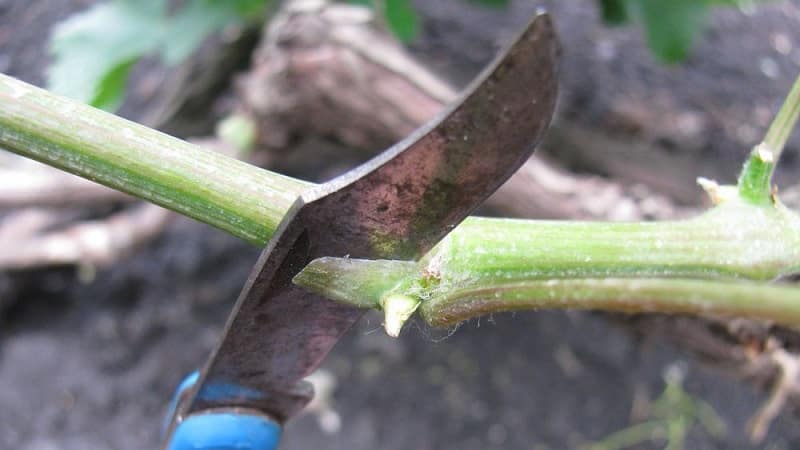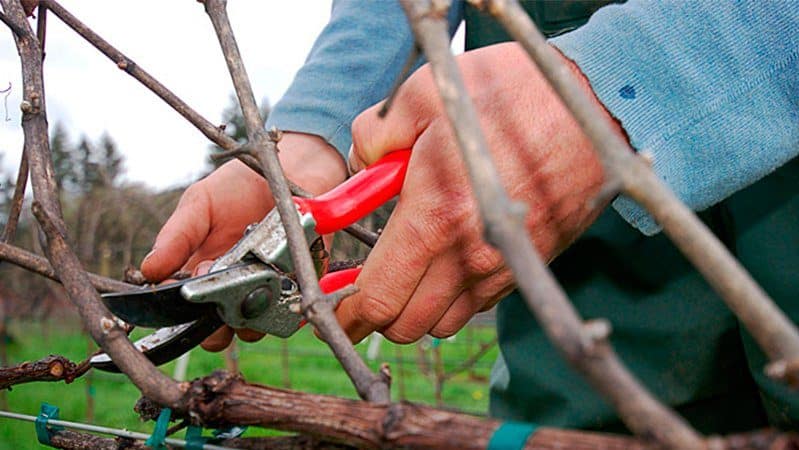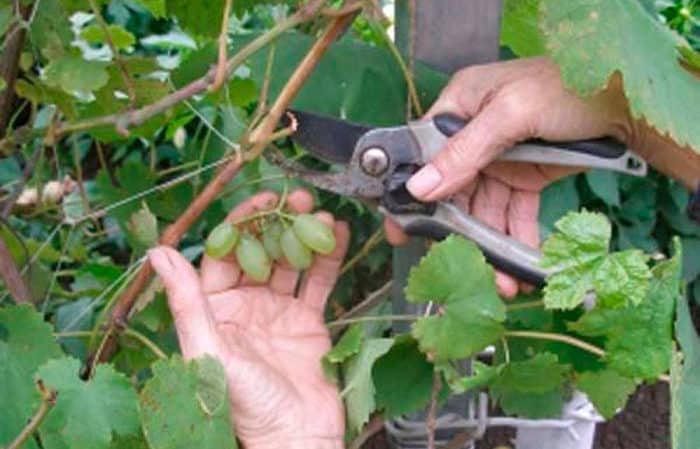A step-by-step guide to pruning grapes in summer for beginning winegrowers
Important procedures for caring for grapes include pruning. Not only the appearance of the plant, but also the quality of the harvest depends on it. If you do not prune in the summer, nutrients will be directed to the growth of new shoots, and the berries will turn out tasteless and small.
Why prune grapes in summer?
Summer pruning is also called green pruning, as it is intended for removing young shoots, inflorescences, brushes and leaves.
This preventative procedure helps the berries ripen and strengthens the vine. In central Russia it will not be possible to get a good harvest without summer pruning.
Pruning goals

The main goals of pruning in summer:
- Creating a balance between barren and fruitful weaves. If there are too many fruitless shoots on the vine, they will take away the nutrients needed to form fruit. If only fruitful branches remain, the harvest will be small and tasteless.
- Ripening of large bunches.
- Acceleration of berry ripening. Moisture and nutrients reach the inflorescences faster.
- Airing the bush.
- Simplifying care.
- Improvement of the vine.
After pruning, the plant tolerates frost and disease more easily.
Timing of the procedure
Trimming directly related to the stages of plant development: vegetation, flowering, formation and ripening of berries. They depend on climatic conditions and growing region.
Duration of the procedure:
- at the end of May - pinching fruit-bearing shoots and removing young shoots;
- in July - stepsoning;
- in August - minting and clarification.
Grape pruning schemes

The vine is formed during the first 3-4 years. This is required for better ventilation.
The standardless pruning option is suitable for regions with a cool climate, where grapes are covered for the winter. At the same time, they try to get a limited number of sleeves that diverge in 2 directions.
How to trim:
- First 2 years. During this time, up to 4 shoots approximately 1 m long are formed. They are inspected, the 2 strongest are selected and cut into 3 eyes. The remaining branches are removed completely.
- Third year. Select 3-4 developed shoots that diverge in different directions. They are cut to 50 cm and tied at an angle to the trellis.
- Fourth year. Cut the vine at the offset knot level. As a result, there should be 4 fruiting vines left, which annually produce up to 18 clusters.
Standard formation allows you to increase the yield by about 40%. Thanks to this scheme, large clusters ripen and plant care is simplified. The method is only suitable for tall varieties.
Procedure:
- A stake 1.5 m long is dug in next to the vineyard. Developing shoots are fixed to it.
- When the length of the central stem reaches 60 cm, the top of the second stem is pinched.
- Next year, the main shoot is cut off at the trunk level, and everything else is completely removed.
- The vine is trimmed, leaving only 2 eyes, and other branches are removed.
- As the shoots grow, pinch off the tops.
By the third year, stepsons are formed, from which a fruit vine appears.
Basic pruning steps

Removal of stepsons is carried out immediately after flowering.If this is not done, the bush will become too overgrown, and the berries will become small and sour.
For pinching, take a thin branch and press on it with your thumb - it will easily break. The stepson is not broken off at the very base, otherwise a new shoot will soon appear from that place. It is enough to pinch off 1.5–2 cm. This procedure is repeated every week.
Pinching is the cutting off of the growth point of a branch to stop its growth. The main purpose of this operation is to stimulate the formation of bunches.
To do this, pinch off the upper part of the lashes by about 3 cm. This redirects nutrients to the inflorescences. If this procedure is not followed, the flowers will receive insufficient nutrition, which will lead to their shedding. Pinching is especially important for varieties that have loose clusters. The operation is performed every 2 weeks.
Minting is carried out at the end of summer. The procedure is very similar to pinching, but differs in that up to 40 cm of shoots are removed. As a result, 15 productive leaves should remain on the trimmed branch.
Important! Chasing speeds up the ripening of fruits. It is especially important to do this for late, vigorous varieties. Without this stage, the crop simply will not have time to ripen. For early varieties, the procedure is optional.
Clarification, or removal of foliage, is done when the berries are already filling. Main goals of the procedure:
- lightening the vines so that the grapes receive more sunlight;
- prevention of gray rot and other diseases;
- improving ventilation of bushes.
On each shoot, remove 5–10 old and yellowed leaves that cover the bunches from light and grow from below.
The tendrils of grapes are modified shoots, so they also take some of the nutrients from the grapes. This impairs overall generative development.Mustaches are trimmed throughout the summer. Having retreated 1-2 cm from the branch, they are removed with your fingers or pruning shears. If you plan to form a vine along any kind of fastening, the topmost tendrils are left and the rest are cut off.
How to properly prune grapes in summer

If you do not control the grapes by pruning, the extra shoots will grow excessively, taking away strength and nutrients from the fruit.
All procedures are usually performed manually, without using tools. However, some winegrowers use pruning shears or a sharp knife, having previously disinfected them.
Step-by-step instruction
Depending on the phase of plant development, the following stages of pruning are distinguished:
- After the first buds bloom, it becomes clear which branches will not bear fruit. They are immediately removed along with weak shoots.
- In mid-June, pinch off the branches on which the clusters have appeared. The shoots are cut off slightly above the top bunch.
- Only 1-2 bunches are left on each branch.
- After flowering, pinching is carried out throughout the summer. New branches are removed at the stage of their formation.
- In early August, minting is carried out. Select unnecessary branches and cut them in half. Fruiting shoots are shortened by 40 cm.
- 15 days before the harvest ripens, most of the foliage is removed, especially that which covers the bunches from the sun.
Mistakes to Avoid
In summer it is difficult to harm the plant, but some gardeners feel sorry for removing fruit-bearing shoots.
Consequences of improper pruning:
- Insufficient removal of the upper parts of branches leads to a rapid increase in green mass, which has a bad effect on the quality and quantity of the harvest.
- Early minting leads to the fact that useful substances will not be used for ripening the berries, but for the formation of new branches. It is performed only after the growth of the bush has been inhibited.
- Excessive lightening can damage the bushes. Only those leaves that shade the fruit are removed.
Completing the pruning steps in a timely manner will rejuvenate the plant and prepare it for winter.
The nuances of pruning young and old grapes

The timing and methods of summer pruning for grapes of different ages are similar. The only difference is for autumn haircuts, after the leaves fall.
Non-viable branches are removed from old bushes. To identify them, it is enough to cut off a small part: if the cut is green, it means the shoot is alive.
For different growing regions
The only difference is the removal of foliage. In the cool conditions of the middle zone, lightening is carried out regularly, and in the southern regions only plants on which fruit ripening is delayed are thinned out.
Caring for grapes after pruning
Removing green shoots practically does not damage the plant, so care remains standard:
- watering 2 times a month at the rate of 1 bucket of water per plant;
- regular loosening and mulching of the root space;
- fertilizing with ammonium sulfate and ammonium nitrate;
- tying the vine to a support.
Be sure to regularly inspect plants for diseases and pests. Young shoots are removed manually, but so that damage is minimal.
Advice from experienced winegrowers
Summer pruning is considered preventive and formative.
In order not to harm the bush, it is better to follow these recommendations:
- carry out each stage in its own time, otherwise there will be no point in them;
- due to a possible decrease in the protective functions of the vine after pruning, treat the grapes with fungicides to prevent diseases;
- if gray rot occurs, spray the bushes with potassium permanganate and the grapes with a solution of baking soda;
- After a hail or hurricane, cut off all damaged branches.
This is interesting:
Why do you need to prune grapes in the fall and how to do it correctly?
Conclusion
Summer pruning is an important procedure that preserves the health of grapes and increases yield. It is carried out in several stages: in June, non-fruit-bearing branches are removed and fruit-bearing ones are pinched, in August, chasing is carried out, and throughout the summer, pinching is carried out.
It is important after the procedures to properly care for the crop, regularly watering it and feeding it.